Essay: Diagnosing & Implementing Change in Organizations
VerifiedAdded on 2023/06/04
|13
|3050
|60
Essay
AI Summary
This essay delves into the critical aspects of organizational change, examining three prominent models: Lewin's Change Management Model, McKinsey's 7-S Model, and Kotter's 8-Step Change Model. It provides a detailed description of each model, outlining their core principles and stages of implementation. Furthermore, the essay offers a critical analysis of these models, evaluating their strengths, weaknesses, and applicability in various organizational contexts. The discussion extends to the identification of both internal and external sources of change that impact organizations, such as processes, structure, human resources, economic factors, technology, and political environments. The essay then explores how these sources of change influence the appropriateness of each model for an individual organization, offering insights into how organizations can select and adapt change management strategies based on their specific circumstances and needs. The essay is thoroughly researched, using peer-reviewed journals and textbooks, providing a comprehensive understanding of the topic.
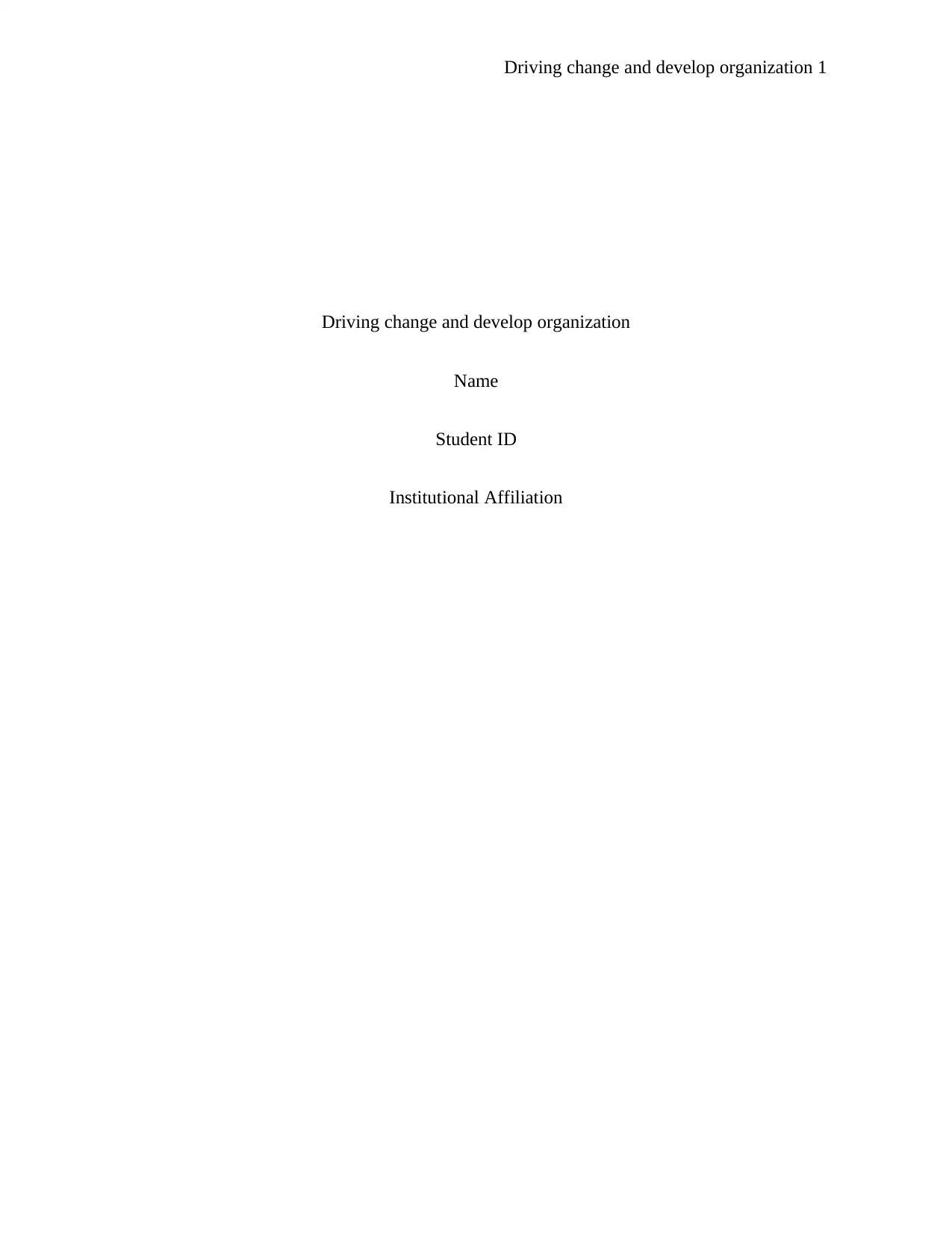
Driving change and develop organization 1
Driving change and develop organization
Name
Student ID
Institutional Affiliation
Driving change and develop organization
Name
Student ID
Institutional Affiliation
Paraphrase This Document
Need a fresh take? Get an instant paraphrase of this document with our AI Paraphraser
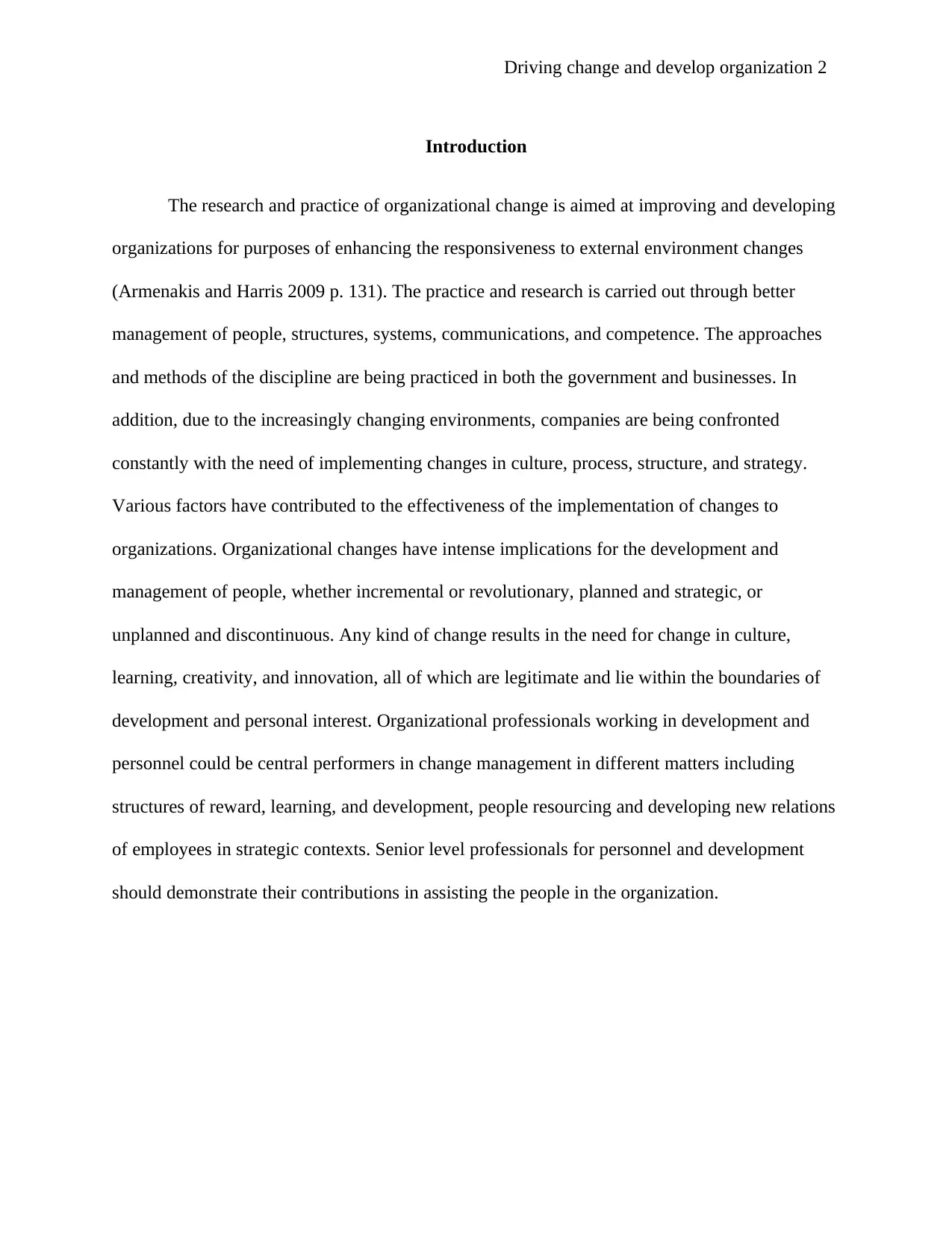
Driving change and develop organization 2
Introduction
The research and practice of organizational change is aimed at improving and developing
organizations for purposes of enhancing the responsiveness to external environment changes
(Armenakis and Harris 2009 p. 131). The practice and research is carried out through better
management of people, structures, systems, communications, and competence. The approaches
and methods of the discipline are being practiced in both the government and businesses. In
addition, due to the increasingly changing environments, companies are being confronted
constantly with the need of implementing changes in culture, process, structure, and strategy.
Various factors have contributed to the effectiveness of the implementation of changes to
organizations. Organizational changes have intense implications for the development and
management of people, whether incremental or revolutionary, planned and strategic, or
unplanned and discontinuous. Any kind of change results in the need for change in culture,
learning, creativity, and innovation, all of which are legitimate and lie within the boundaries of
development and personal interest. Organizational professionals working in development and
personnel could be central performers in change management in different matters including
structures of reward, learning, and development, people resourcing and developing new relations
of employees in strategic contexts. Senior level professionals for personnel and development
should demonstrate their contributions in assisting the people in the organization.
Introduction
The research and practice of organizational change is aimed at improving and developing
organizations for purposes of enhancing the responsiveness to external environment changes
(Armenakis and Harris 2009 p. 131). The practice and research is carried out through better
management of people, structures, systems, communications, and competence. The approaches
and methods of the discipline are being practiced in both the government and businesses. In
addition, due to the increasingly changing environments, companies are being confronted
constantly with the need of implementing changes in culture, process, structure, and strategy.
Various factors have contributed to the effectiveness of the implementation of changes to
organizations. Organizational changes have intense implications for the development and
management of people, whether incremental or revolutionary, planned and strategic, or
unplanned and discontinuous. Any kind of change results in the need for change in culture,
learning, creativity, and innovation, all of which are legitimate and lie within the boundaries of
development and personal interest. Organizational professionals working in development and
personnel could be central performers in change management in different matters including
structures of reward, learning, and development, people resourcing and developing new relations
of employees in strategic contexts. Senior level professionals for personnel and development
should demonstrate their contributions in assisting the people in the organization.
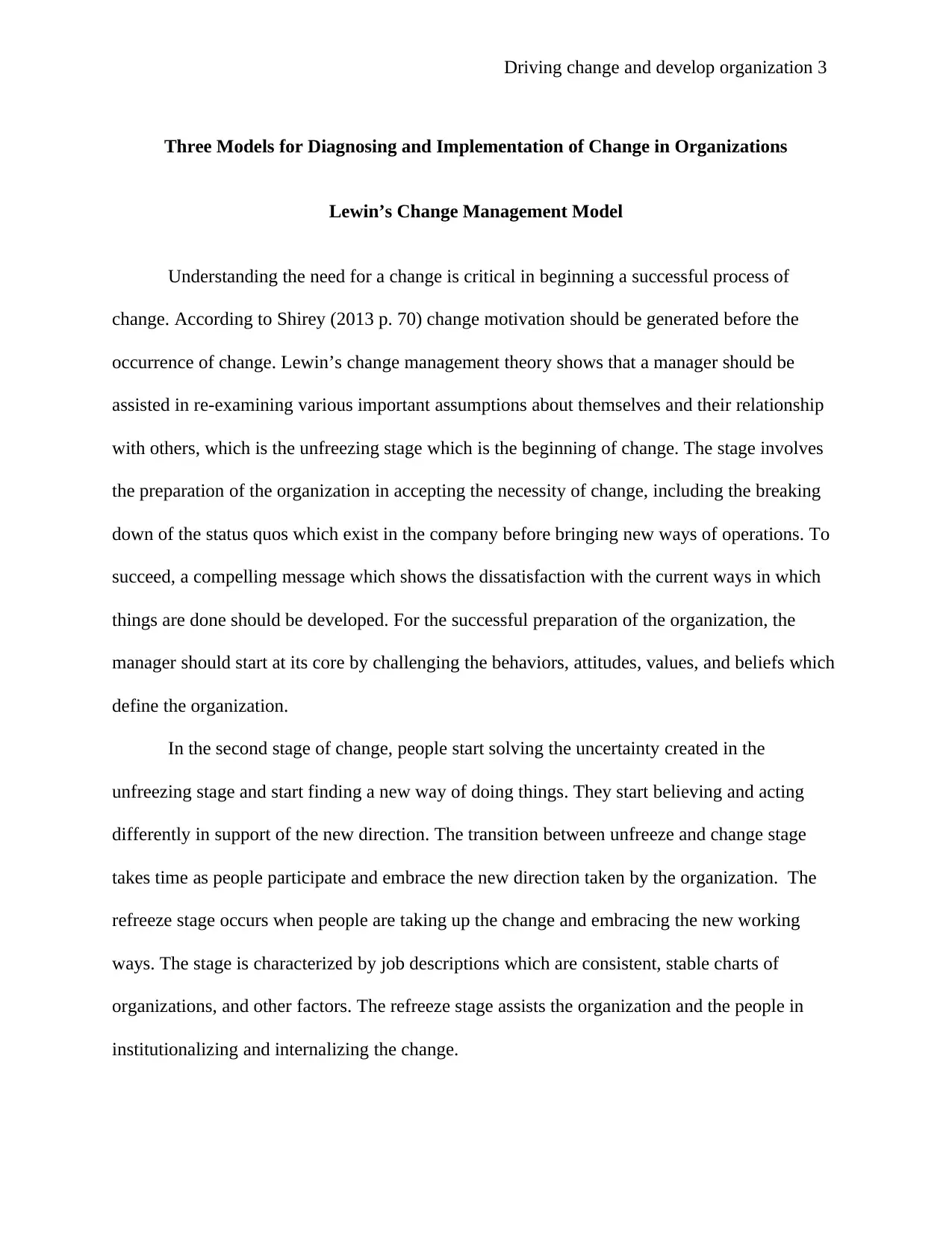
Driving change and develop organization 3
Three Models for Diagnosing and Implementation of Change in Organizations
Lewin’s Change Management Model
Understanding the need for a change is critical in beginning a successful process of
change. According to Shirey (2013 p. 70) change motivation should be generated before the
occurrence of change. Lewin’s change management theory shows that a manager should be
assisted in re-examining various important assumptions about themselves and their relationship
with others, which is the unfreezing stage which is the beginning of change. The stage involves
the preparation of the organization in accepting the necessity of change, including the breaking
down of the status quos which exist in the company before bringing new ways of operations. To
succeed, a compelling message which shows the dissatisfaction with the current ways in which
things are done should be developed. For the successful preparation of the organization, the
manager should start at its core by challenging the behaviors, attitudes, values, and beliefs which
define the organization.
In the second stage of change, people start solving the uncertainty created in the
unfreezing stage and start finding a new way of doing things. They start believing and acting
differently in support of the new direction. The transition between unfreeze and change stage
takes time as people participate and embrace the new direction taken by the organization. The
refreeze stage occurs when people are taking up the change and embracing the new working
ways. The stage is characterized by job descriptions which are consistent, stable charts of
organizations, and other factors. The refreeze stage assists the organization and the people in
institutionalizing and internalizing the change.
Three Models for Diagnosing and Implementation of Change in Organizations
Lewin’s Change Management Model
Understanding the need for a change is critical in beginning a successful process of
change. According to Shirey (2013 p. 70) change motivation should be generated before the
occurrence of change. Lewin’s change management theory shows that a manager should be
assisted in re-examining various important assumptions about themselves and their relationship
with others, which is the unfreezing stage which is the beginning of change. The stage involves
the preparation of the organization in accepting the necessity of change, including the breaking
down of the status quos which exist in the company before bringing new ways of operations. To
succeed, a compelling message which shows the dissatisfaction with the current ways in which
things are done should be developed. For the successful preparation of the organization, the
manager should start at its core by challenging the behaviors, attitudes, values, and beliefs which
define the organization.
In the second stage of change, people start solving the uncertainty created in the
unfreezing stage and start finding a new way of doing things. They start believing and acting
differently in support of the new direction. The transition between unfreeze and change stage
takes time as people participate and embrace the new direction taken by the organization. The
refreeze stage occurs when people are taking up the change and embracing the new working
ways. The stage is characterized by job descriptions which are consistent, stable charts of
organizations, and other factors. The refreeze stage assists the organization and the people in
institutionalizing and internalizing the change.
⊘ This is a preview!⊘
Do you want full access?
Subscribe today to unlock all pages.

Trusted by 1+ million students worldwide
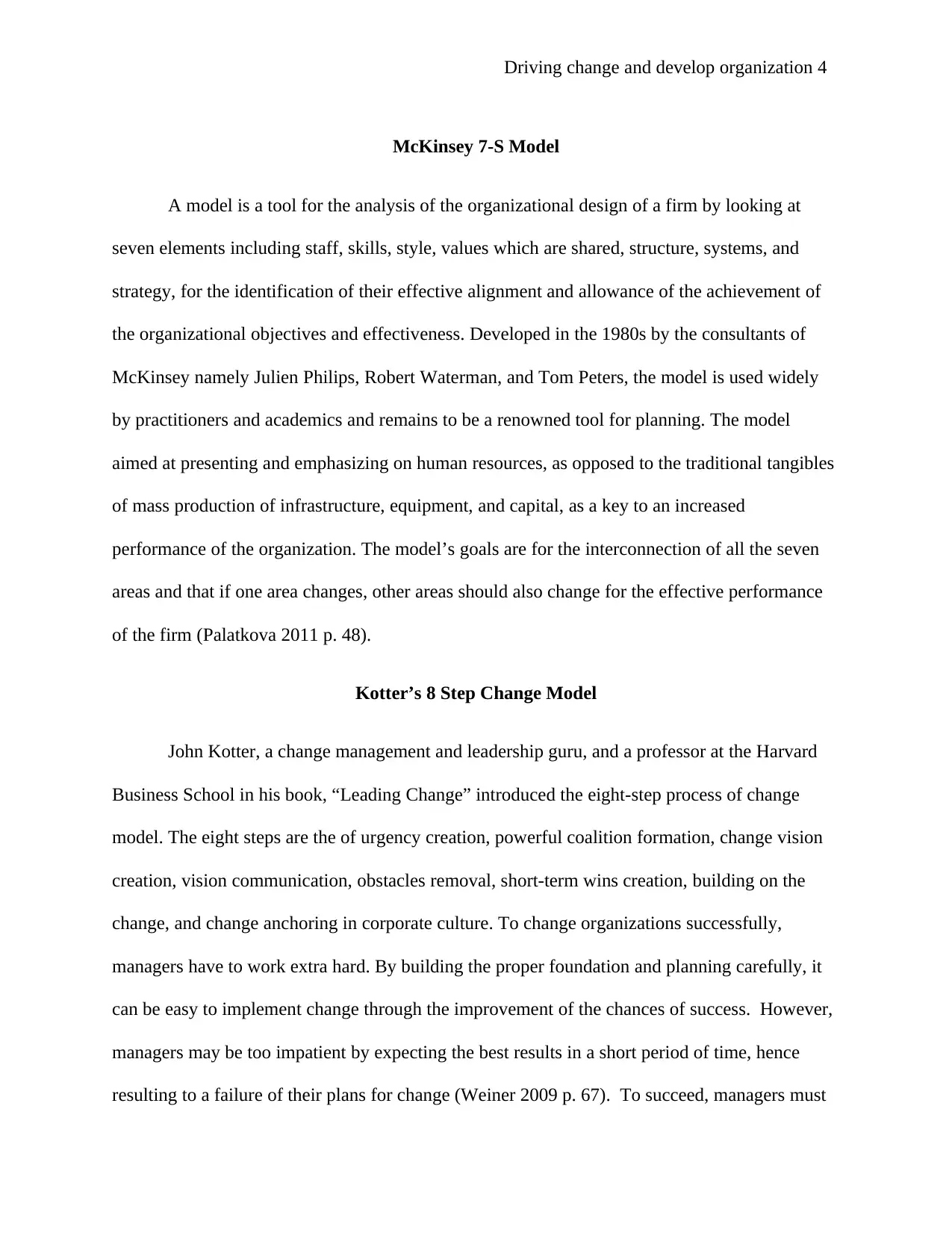
Driving change and develop organization 4
McKinsey 7-S Model
A model is a tool for the analysis of the organizational design of a firm by looking at
seven elements including staff, skills, style, values which are shared, structure, systems, and
strategy, for the identification of their effective alignment and allowance of the achievement of
the organizational objectives and effectiveness. Developed in the 1980s by the consultants of
McKinsey namely Julien Philips, Robert Waterman, and Tom Peters, the model is used widely
by practitioners and academics and remains to be a renowned tool for planning. The model
aimed at presenting and emphasizing on human resources, as opposed to the traditional tangibles
of mass production of infrastructure, equipment, and capital, as a key to an increased
performance of the organization. The model’s goals are for the interconnection of all the seven
areas and that if one area changes, other areas should also change for the effective performance
of the firm (Palatkova 2011 p. 48).
Kotter’s 8 Step Change Model
John Kotter, a change management and leadership guru, and a professor at the Harvard
Business School in his book, “Leading Change” introduced the eight-step process of change
model. The eight steps are the of urgency creation, powerful coalition formation, change vision
creation, vision communication, obstacles removal, short-term wins creation, building on the
change, and change anchoring in corporate culture. To change organizations successfully,
managers have to work extra hard. By building the proper foundation and planning carefully, it
can be easy to implement change through the improvement of the chances of success. However,
managers may be too impatient by expecting the best results in a short period of time, hence
resulting to a failure of their plans for change (Weiner 2009 p. 67). To succeed, managers must
McKinsey 7-S Model
A model is a tool for the analysis of the organizational design of a firm by looking at
seven elements including staff, skills, style, values which are shared, structure, systems, and
strategy, for the identification of their effective alignment and allowance of the achievement of
the organizational objectives and effectiveness. Developed in the 1980s by the consultants of
McKinsey namely Julien Philips, Robert Waterman, and Tom Peters, the model is used widely
by practitioners and academics and remains to be a renowned tool for planning. The model
aimed at presenting and emphasizing on human resources, as opposed to the traditional tangibles
of mass production of infrastructure, equipment, and capital, as a key to an increased
performance of the organization. The model’s goals are for the interconnection of all the seven
areas and that if one area changes, other areas should also change for the effective performance
of the firm (Palatkova 2011 p. 48).
Kotter’s 8 Step Change Model
John Kotter, a change management and leadership guru, and a professor at the Harvard
Business School in his book, “Leading Change” introduced the eight-step process of change
model. The eight steps are the of urgency creation, powerful coalition formation, change vision
creation, vision communication, obstacles removal, short-term wins creation, building on the
change, and change anchoring in corporate culture. To change organizations successfully,
managers have to work extra hard. By building the proper foundation and planning carefully, it
can be easy to implement change through the improvement of the chances of success. However,
managers may be too impatient by expecting the best results in a short period of time, hence
resulting to a failure of their plans for change (Weiner 2009 p. 67). To succeed, managers must
Paraphrase This Document
Need a fresh take? Get an instant paraphrase of this document with our AI Paraphraser
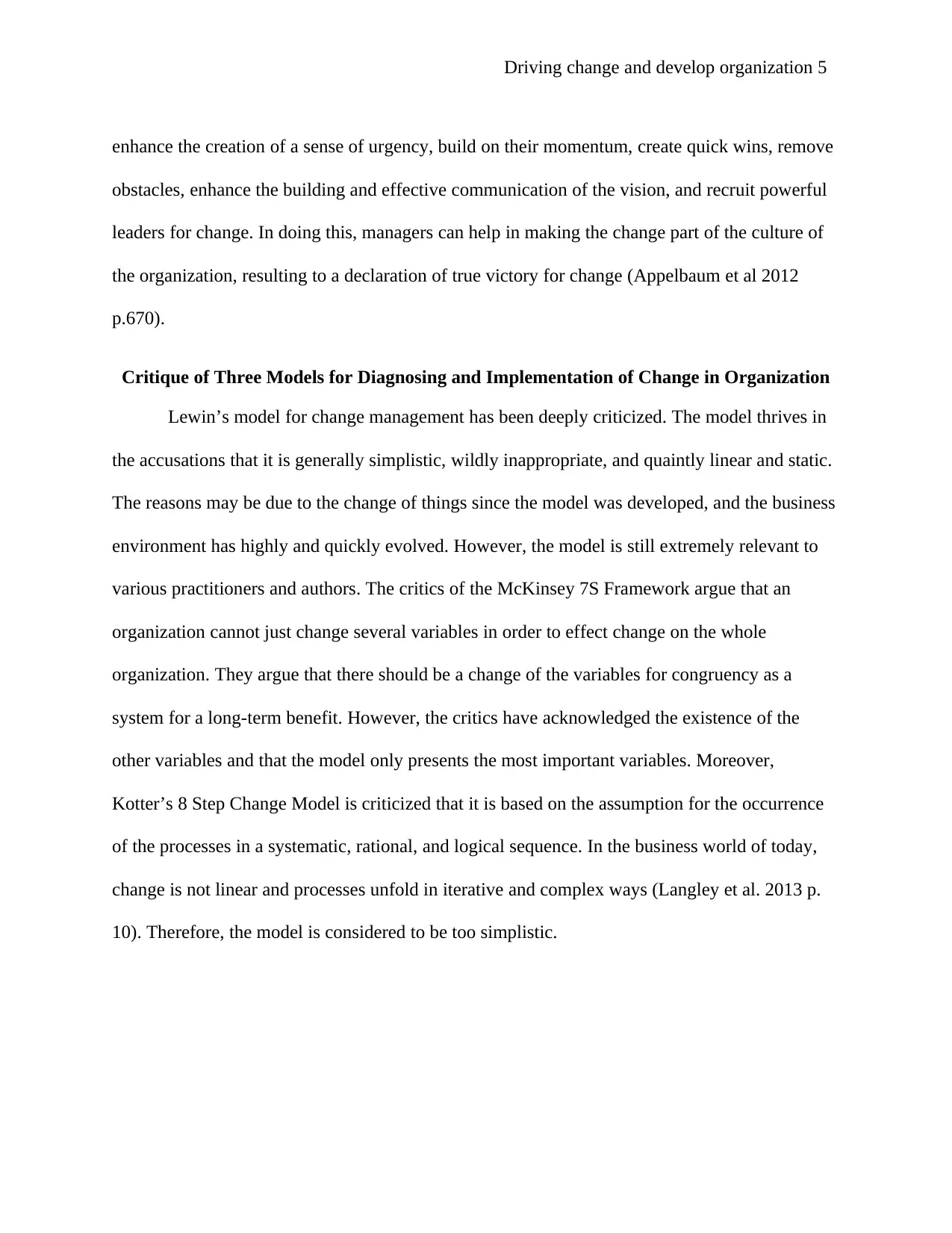
Driving change and develop organization 5
enhance the creation of a sense of urgency, build on their momentum, create quick wins, remove
obstacles, enhance the building and effective communication of the vision, and recruit powerful
leaders for change. In doing this, managers can help in making the change part of the culture of
the organization, resulting to a declaration of true victory for change (Appelbaum et al 2012
p.670).
Critique of Three Models for Diagnosing and Implementation of Change in Organization
Lewin’s model for change management has been deeply criticized. The model thrives in
the accusations that it is generally simplistic, wildly inappropriate, and quaintly linear and static.
The reasons may be due to the change of things since the model was developed, and the business
environment has highly and quickly evolved. However, the model is still extremely relevant to
various practitioners and authors. The critics of the McKinsey 7S Framework argue that an
organization cannot just change several variables in order to effect change on the whole
organization. They argue that there should be a change of the variables for congruency as a
system for a long-term benefit. However, the critics have acknowledged the existence of the
other variables and that the model only presents the most important variables. Moreover,
Kotter’s 8 Step Change Model is criticized that it is based on the assumption for the occurrence
of the processes in a systematic, rational, and logical sequence. In the business world of today,
change is not linear and processes unfold in iterative and complex ways (Langley et al. 2013 p.
10). Therefore, the model is considered to be too simplistic.
enhance the creation of a sense of urgency, build on their momentum, create quick wins, remove
obstacles, enhance the building and effective communication of the vision, and recruit powerful
leaders for change. In doing this, managers can help in making the change part of the culture of
the organization, resulting to a declaration of true victory for change (Appelbaum et al 2012
p.670).
Critique of Three Models for Diagnosing and Implementation of Change in Organization
Lewin’s model for change management has been deeply criticized. The model thrives in
the accusations that it is generally simplistic, wildly inappropriate, and quaintly linear and static.
The reasons may be due to the change of things since the model was developed, and the business
environment has highly and quickly evolved. However, the model is still extremely relevant to
various practitioners and authors. The critics of the McKinsey 7S Framework argue that an
organization cannot just change several variables in order to effect change on the whole
organization. They argue that there should be a change of the variables for congruency as a
system for a long-term benefit. However, the critics have acknowledged the existence of the
other variables and that the model only presents the most important variables. Moreover,
Kotter’s 8 Step Change Model is criticized that it is based on the assumption for the occurrence
of the processes in a systematic, rational, and logical sequence. In the business world of today,
change is not linear and processes unfold in iterative and complex ways (Langley et al. 2013 p.
10). Therefore, the model is considered to be too simplistic.
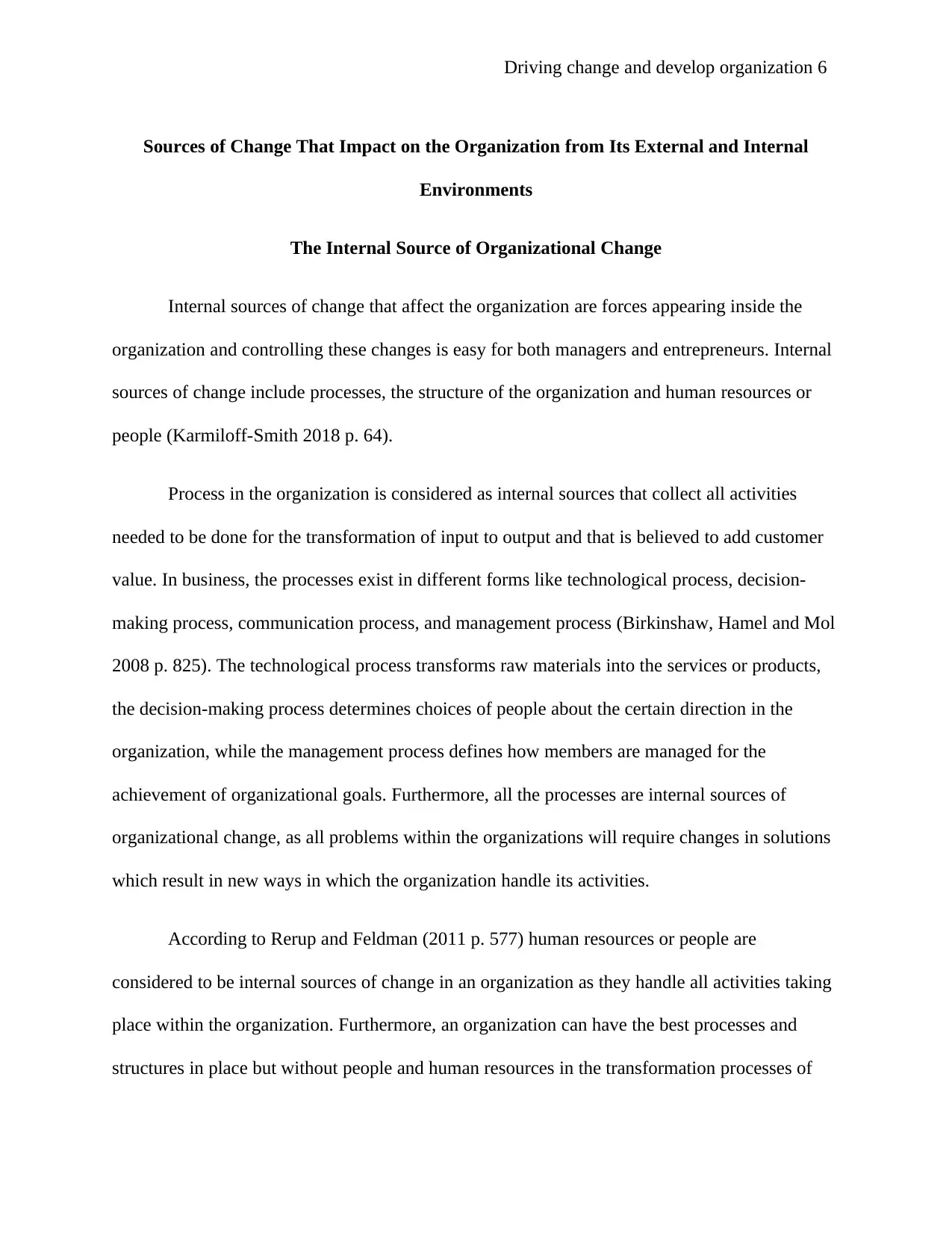
Driving change and develop organization 6
Sources of Change That Impact on the Organization from Its External and Internal
Environments
The Internal Source of Organizational Change
Internal sources of change that affect the organization are forces appearing inside the
organization and controlling these changes is easy for both managers and entrepreneurs. Internal
sources of change include processes, the structure of the organization and human resources or
people (Karmiloff-Smith 2018 p. 64).
Process in the organization is considered as internal sources that collect all activities
needed to be done for the transformation of input to output and that is believed to add customer
value. In business, the processes exist in different forms like technological process, decision-
making process, communication process, and management process (Birkinshaw, Hamel and Mol
2008 p. 825). The technological process transforms raw materials into the services or products,
the decision-making process determines choices of people about the certain direction in the
organization, while the management process defines how members are managed for the
achievement of organizational goals. Furthermore, all the processes are internal sources of
organizational change, as all problems within the organizations will require changes in solutions
which result in new ways in which the organization handle its activities.
According to Rerup and Feldman (2011 p. 577) human resources or people are
considered to be internal sources of change in an organization as they handle all activities taking
place within the organization. Furthermore, an organization can have the best processes and
structures in place but without people and human resources in the transformation processes of
Sources of Change That Impact on the Organization from Its External and Internal
Environments
The Internal Source of Organizational Change
Internal sources of change that affect the organization are forces appearing inside the
organization and controlling these changes is easy for both managers and entrepreneurs. Internal
sources of change include processes, the structure of the organization and human resources or
people (Karmiloff-Smith 2018 p. 64).
Process in the organization is considered as internal sources that collect all activities
needed to be done for the transformation of input to output and that is believed to add customer
value. In business, the processes exist in different forms like technological process, decision-
making process, communication process, and management process (Birkinshaw, Hamel and Mol
2008 p. 825). The technological process transforms raw materials into the services or products,
the decision-making process determines choices of people about the certain direction in the
organization, while the management process defines how members are managed for the
achievement of organizational goals. Furthermore, all the processes are internal sources of
organizational change, as all problems within the organizations will require changes in solutions
which result in new ways in which the organization handle its activities.
According to Rerup and Feldman (2011 p. 577) human resources or people are
considered to be internal sources of change in an organization as they handle all activities taking
place within the organization. Furthermore, an organization can have the best processes and
structures in place but without people and human resources in the transformation processes of
⊘ This is a preview!⊘
Do you want full access?
Subscribe today to unlock all pages.

Trusted by 1+ million students worldwide
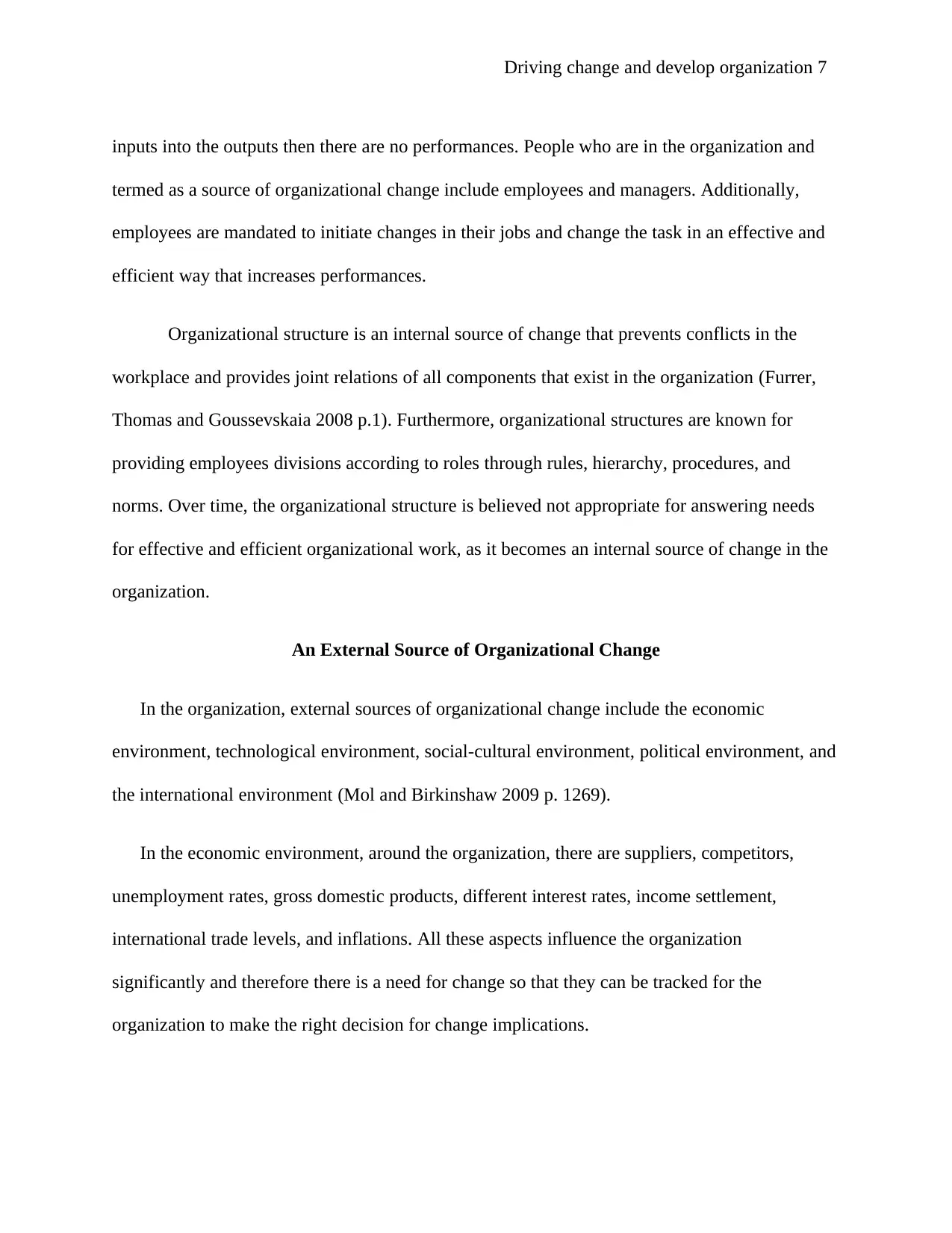
Driving change and develop organization 7
inputs into the outputs then there are no performances. People who are in the organization and
termed as a source of organizational change include employees and managers. Additionally,
employees are mandated to initiate changes in their jobs and change the task in an effective and
efficient way that increases performances.
Organizational structure is an internal source of change that prevents conflicts in the
workplace and provides joint relations of all components that exist in the organization (Furrer,
Thomas and Goussevskaia 2008 p.1). Furthermore, organizational structures are known for
providing employees divisions according to roles through rules, hierarchy, procedures, and
norms. Over time, the organizational structure is believed not appropriate for answering needs
for effective and efficient organizational work, as it becomes an internal source of change in the
organization.
An External Source of Organizational Change
In the organization, external sources of organizational change include the economic
environment, technological environment, social-cultural environment, political environment, and
the international environment (Mol and Birkinshaw 2009 p. 1269).
In the economic environment, around the organization, there are suppliers, competitors,
unemployment rates, gross domestic products, different interest rates, income settlement,
international trade levels, and inflations. All these aspects influence the organization
significantly and therefore there is a need for change so that they can be tracked for the
organization to make the right decision for change implications.
inputs into the outputs then there are no performances. People who are in the organization and
termed as a source of organizational change include employees and managers. Additionally,
employees are mandated to initiate changes in their jobs and change the task in an effective and
efficient way that increases performances.
Organizational structure is an internal source of change that prevents conflicts in the
workplace and provides joint relations of all components that exist in the organization (Furrer,
Thomas and Goussevskaia 2008 p.1). Furthermore, organizational structures are known for
providing employees divisions according to roles through rules, hierarchy, procedures, and
norms. Over time, the organizational structure is believed not appropriate for answering needs
for effective and efficient organizational work, as it becomes an internal source of change in the
organization.
An External Source of Organizational Change
In the organization, external sources of organizational change include the economic
environment, technological environment, social-cultural environment, political environment, and
the international environment (Mol and Birkinshaw 2009 p. 1269).
In the economic environment, around the organization, there are suppliers, competitors,
unemployment rates, gross domestic products, different interest rates, income settlement,
international trade levels, and inflations. All these aspects influence the organization
significantly and therefore there is a need for change so that they can be tracked for the
organization to make the right decision for change implications.
Paraphrase This Document
Need a fresh take? Get an instant paraphrase of this document with our AI Paraphraser
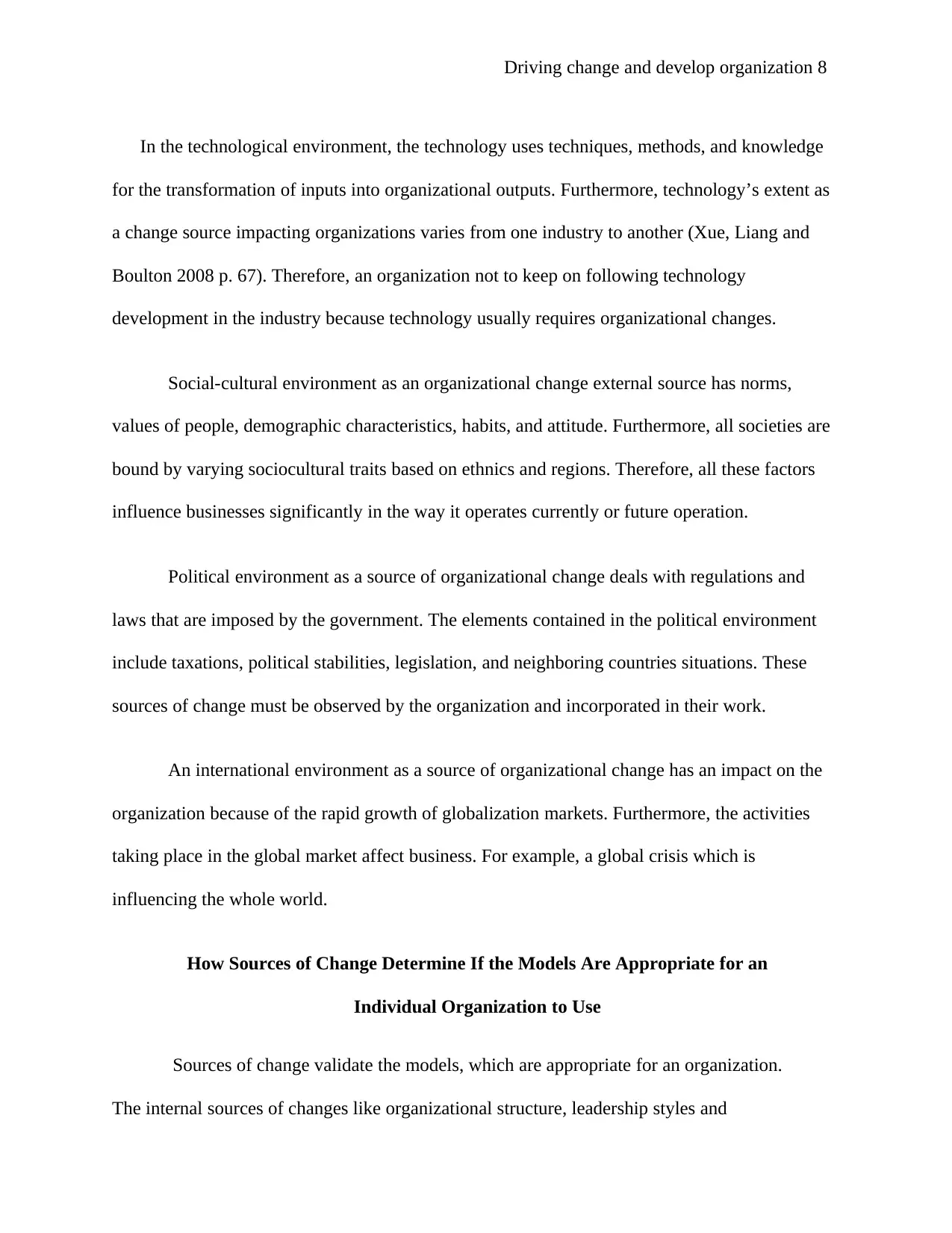
Driving change and develop organization 8
In the technological environment, the technology uses techniques, methods, and knowledge
for the transformation of inputs into organizational outputs. Furthermore, technology’s extent as
a change source impacting organizations varies from one industry to another (Xue, Liang and
Boulton 2008 p. 67). Therefore, an organization not to keep on following technology
development in the industry because technology usually requires organizational changes.
Social-cultural environment as an organizational change external source has norms,
values of people, demographic characteristics, habits, and attitude. Furthermore, all societies are
bound by varying sociocultural traits based on ethnics and regions. Therefore, all these factors
influence businesses significantly in the way it operates currently or future operation.
Political environment as a source of organizational change deals with regulations and
laws that are imposed by the government. The elements contained in the political environment
include taxations, political stabilities, legislation, and neighboring countries situations. These
sources of change must be observed by the organization and incorporated in their work.
An international environment as a source of organizational change has an impact on the
organization because of the rapid growth of globalization markets. Furthermore, the activities
taking place in the global market affect business. For example, a global crisis which is
influencing the whole world.
How Sources of Change Determine If the Models Are Appropriate for an
Individual Organization to Use
Sources of change validate the models, which are appropriate for an organization.
The internal sources of changes like organizational structure, leadership styles and
In the technological environment, the technology uses techniques, methods, and knowledge
for the transformation of inputs into organizational outputs. Furthermore, technology’s extent as
a change source impacting organizations varies from one industry to another (Xue, Liang and
Boulton 2008 p. 67). Therefore, an organization not to keep on following technology
development in the industry because technology usually requires organizational changes.
Social-cultural environment as an organizational change external source has norms,
values of people, demographic characteristics, habits, and attitude. Furthermore, all societies are
bound by varying sociocultural traits based on ethnics and regions. Therefore, all these factors
influence businesses significantly in the way it operates currently or future operation.
Political environment as a source of organizational change deals with regulations and
laws that are imposed by the government. The elements contained in the political environment
include taxations, political stabilities, legislation, and neighboring countries situations. These
sources of change must be observed by the organization and incorporated in their work.
An international environment as a source of organizational change has an impact on the
organization because of the rapid growth of globalization markets. Furthermore, the activities
taking place in the global market affect business. For example, a global crisis which is
influencing the whole world.
How Sources of Change Determine If the Models Are Appropriate for an
Individual Organization to Use
Sources of change validate the models, which are appropriate for an organization.
The internal sources of changes like organizational structure, leadership styles and
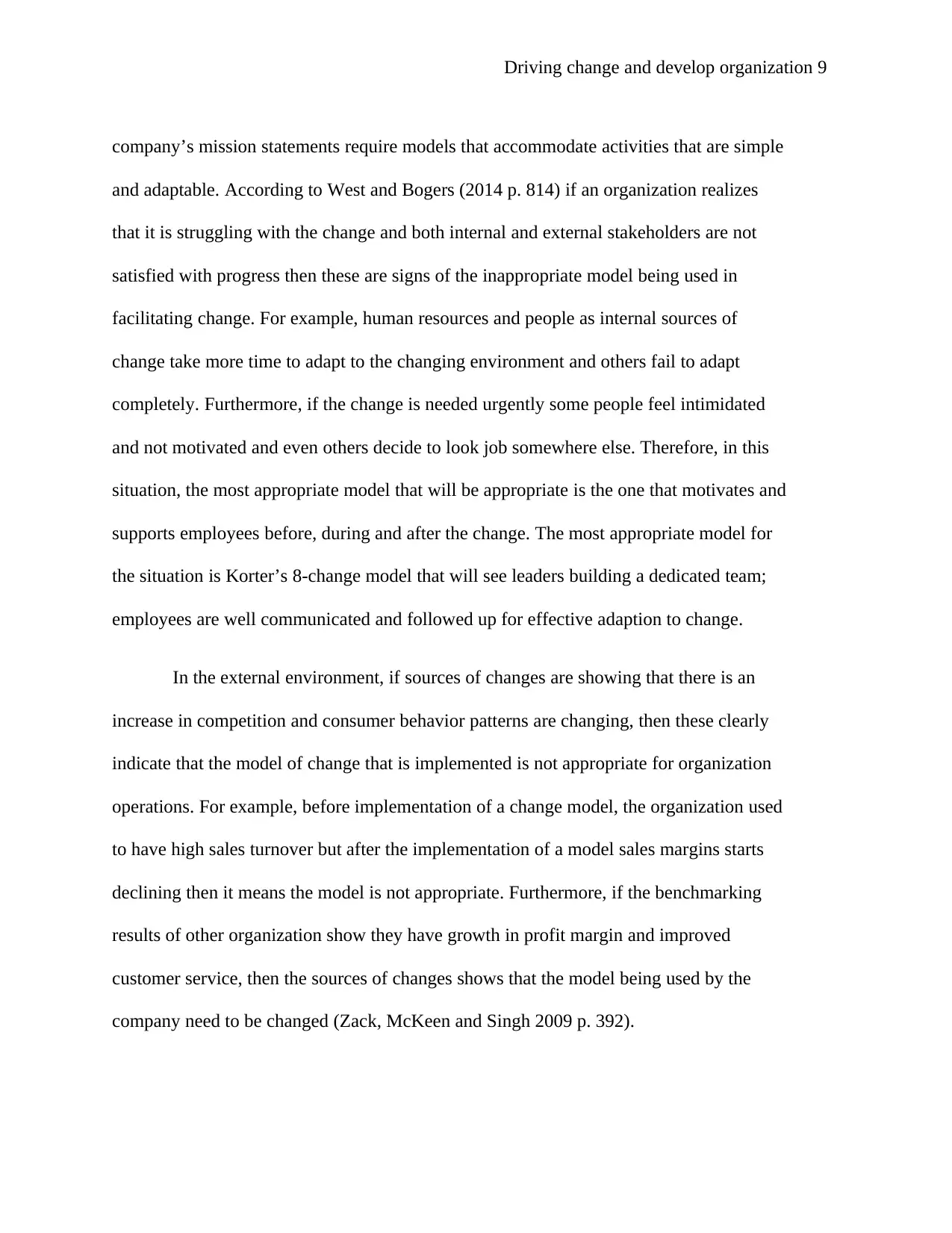
Driving change and develop organization 9
company’s mission statements require models that accommodate activities that are simple
and adaptable. According to West and Bogers (2014 p. 814) if an organization realizes
that it is struggling with the change and both internal and external stakeholders are not
satisfied with progress then these are signs of the inappropriate model being used in
facilitating change. For example, human resources and people as internal sources of
change take more time to adapt to the changing environment and others fail to adapt
completely. Furthermore, if the change is needed urgently some people feel intimidated
and not motivated and even others decide to look job somewhere else. Therefore, in this
situation, the most appropriate model that will be appropriate is the one that motivates and
supports employees before, during and after the change. The most appropriate model for
the situation is Korter’s 8-change model that will see leaders building a dedicated team;
employees are well communicated and followed up for effective adaption to change.
In the external environment, if sources of changes are showing that there is an
increase in competition and consumer behavior patterns are changing, then these clearly
indicate that the model of change that is implemented is not appropriate for organization
operations. For example, before implementation of a change model, the organization used
to have high sales turnover but after the implementation of a model sales margins starts
declining then it means the model is not appropriate. Furthermore, if the benchmarking
results of other organization show they have growth in profit margin and improved
customer service, then the sources of changes shows that the model being used by the
company need to be changed (Zack, McKeen and Singh 2009 p. 392).
company’s mission statements require models that accommodate activities that are simple
and adaptable. According to West and Bogers (2014 p. 814) if an organization realizes
that it is struggling with the change and both internal and external stakeholders are not
satisfied with progress then these are signs of the inappropriate model being used in
facilitating change. For example, human resources and people as internal sources of
change take more time to adapt to the changing environment and others fail to adapt
completely. Furthermore, if the change is needed urgently some people feel intimidated
and not motivated and even others decide to look job somewhere else. Therefore, in this
situation, the most appropriate model that will be appropriate is the one that motivates and
supports employees before, during and after the change. The most appropriate model for
the situation is Korter’s 8-change model that will see leaders building a dedicated team;
employees are well communicated and followed up for effective adaption to change.
In the external environment, if sources of changes are showing that there is an
increase in competition and consumer behavior patterns are changing, then these clearly
indicate that the model of change that is implemented is not appropriate for organization
operations. For example, before implementation of a change model, the organization used
to have high sales turnover but after the implementation of a model sales margins starts
declining then it means the model is not appropriate. Furthermore, if the benchmarking
results of other organization show they have growth in profit margin and improved
customer service, then the sources of changes shows that the model being used by the
company need to be changed (Zack, McKeen and Singh 2009 p. 392).
⊘ This is a preview!⊘
Do you want full access?
Subscribe today to unlock all pages.

Trusted by 1+ million students worldwide
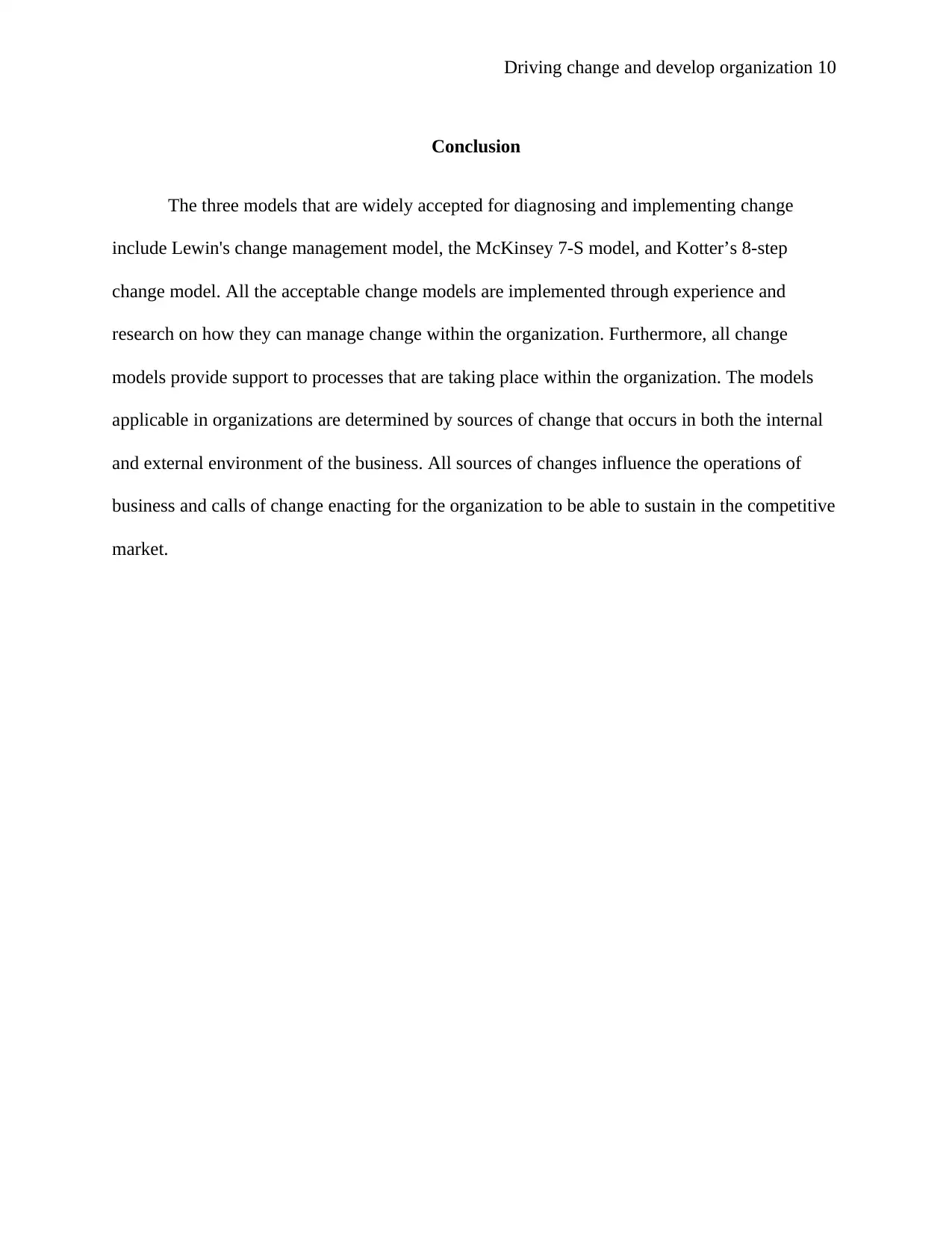
Driving change and develop organization 10
Conclusion
The three models that are widely accepted for diagnosing and implementing change
include Lewin's change management model, the McKinsey 7-S model, and Kotter’s 8-step
change model. All the acceptable change models are implemented through experience and
research on how they can manage change within the organization. Furthermore, all change
models provide support to processes that are taking place within the organization. The models
applicable in organizations are determined by sources of change that occurs in both the internal
and external environment of the business. All sources of changes influence the operations of
business and calls of change enacting for the organization to be able to sustain in the competitive
market.
Conclusion
The three models that are widely accepted for diagnosing and implementing change
include Lewin's change management model, the McKinsey 7-S model, and Kotter’s 8-step
change model. All the acceptable change models are implemented through experience and
research on how they can manage change within the organization. Furthermore, all change
models provide support to processes that are taking place within the organization. The models
applicable in organizations are determined by sources of change that occurs in both the internal
and external environment of the business. All sources of changes influence the operations of
business and calls of change enacting for the organization to be able to sustain in the competitive
market.
Paraphrase This Document
Need a fresh take? Get an instant paraphrase of this document with our AI Paraphraser
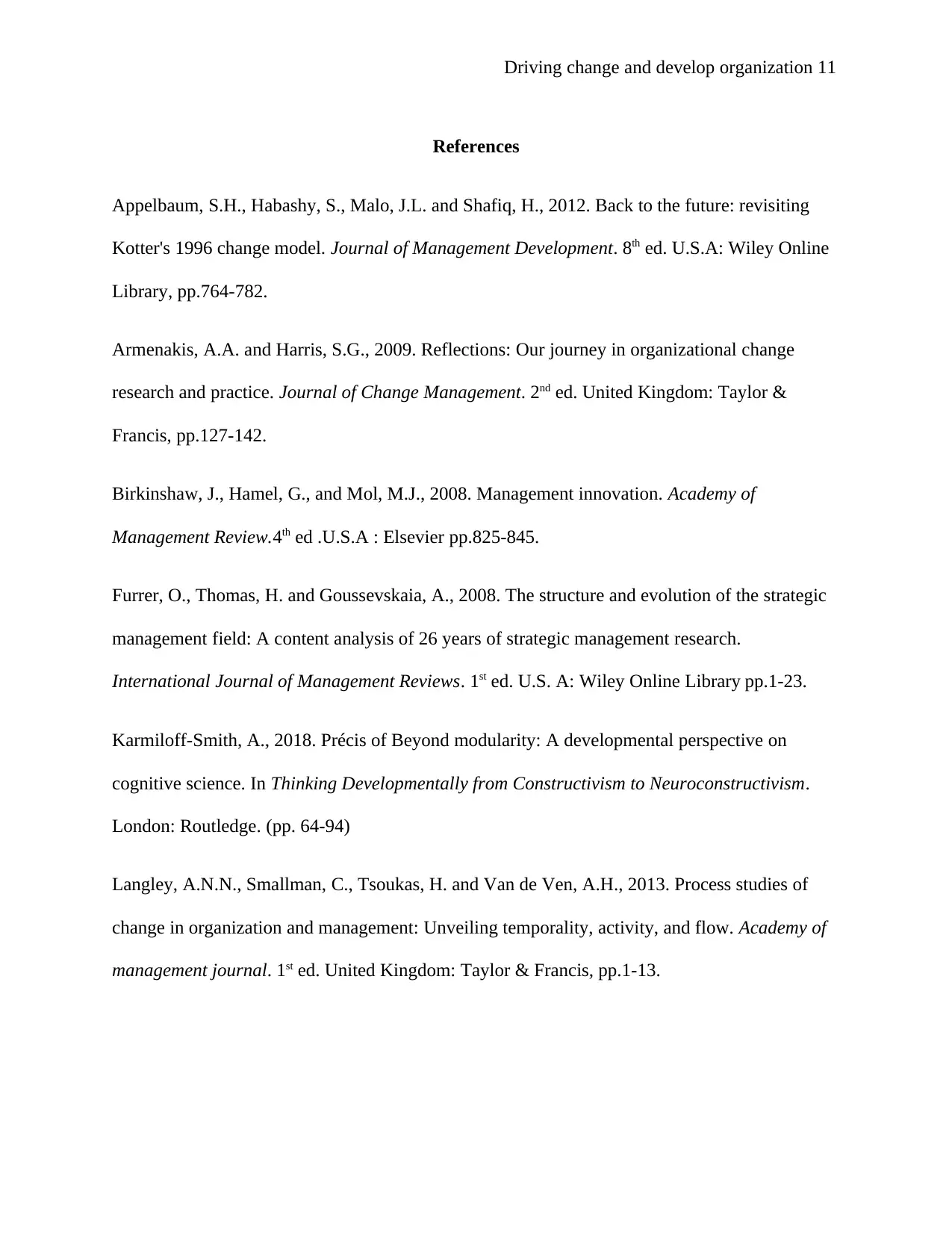
Driving change and develop organization 11
References
Appelbaum, S.H., Habashy, S., Malo, J.L. and Shafiq, H., 2012. Back to the future: revisiting
Kotter's 1996 change model. Journal of Management Development. 8th ed. U.S.A: Wiley Online
Library, pp.764-782.
Armenakis, A.A. and Harris, S.G., 2009. Reflections: Our journey in organizational change
research and practice. Journal of Change Management. 2nd ed. United Kingdom: Taylor &
Francis, pp.127-142.
Birkinshaw, J., Hamel, G., and Mol, M.J., 2008. Management innovation. Academy of
Management Review.4th ed .U.S.A : Elsevier pp.825-845.
Furrer, O., Thomas, H. and Goussevskaia, A., 2008. The structure and evolution of the strategic
management field: A content analysis of 26 years of strategic management research.
International Journal of Management Reviews. 1st ed. U.S. A: Wiley Online Library pp.1-23.
Karmiloff-Smith, A., 2018. Précis of Beyond modularity: A developmental perspective on
cognitive science. In Thinking Developmentally from Constructivism to Neuroconstructivism.
London: Routledge. (pp. 64-94)
Langley, A.N.N., Smallman, C., Tsoukas, H. and Van de Ven, A.H., 2013. Process studies of
change in organization and management: Unveiling temporality, activity, and flow. Academy of
management journal. 1st ed. United Kingdom: Taylor & Francis, pp.1-13.
References
Appelbaum, S.H., Habashy, S., Malo, J.L. and Shafiq, H., 2012. Back to the future: revisiting
Kotter's 1996 change model. Journal of Management Development. 8th ed. U.S.A: Wiley Online
Library, pp.764-782.
Armenakis, A.A. and Harris, S.G., 2009. Reflections: Our journey in organizational change
research and practice. Journal of Change Management. 2nd ed. United Kingdom: Taylor &
Francis, pp.127-142.
Birkinshaw, J., Hamel, G., and Mol, M.J., 2008. Management innovation. Academy of
Management Review.4th ed .U.S.A : Elsevier pp.825-845.
Furrer, O., Thomas, H. and Goussevskaia, A., 2008. The structure and evolution of the strategic
management field: A content analysis of 26 years of strategic management research.
International Journal of Management Reviews. 1st ed. U.S. A: Wiley Online Library pp.1-23.
Karmiloff-Smith, A., 2018. Précis of Beyond modularity: A developmental perspective on
cognitive science. In Thinking Developmentally from Constructivism to Neuroconstructivism.
London: Routledge. (pp. 64-94)
Langley, A.N.N., Smallman, C., Tsoukas, H. and Van de Ven, A.H., 2013. Process studies of
change in organization and management: Unveiling temporality, activity, and flow. Academy of
management journal. 1st ed. United Kingdom: Taylor & Francis, pp.1-13.
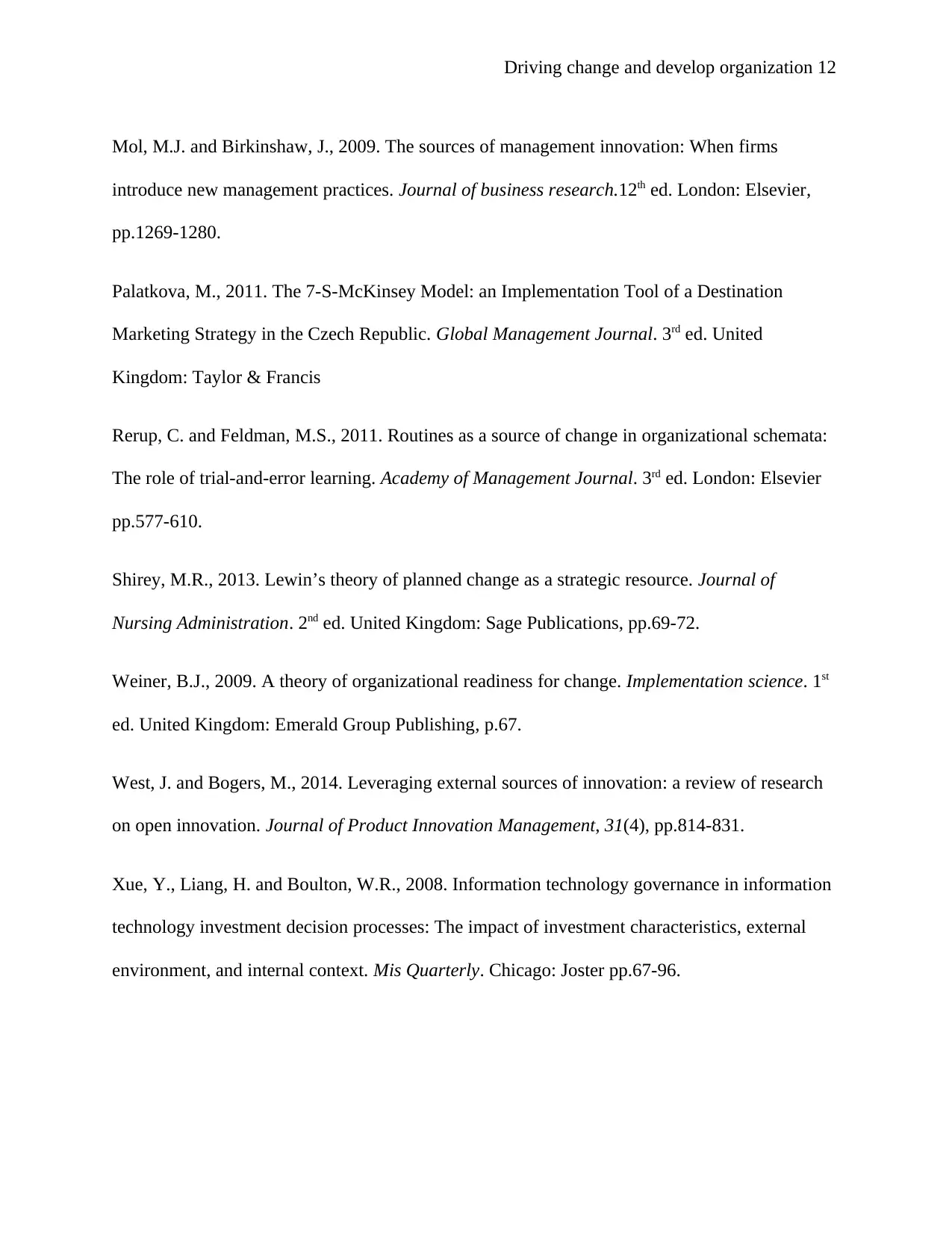
Driving change and develop organization 12
Mol, M.J. and Birkinshaw, J., 2009. The sources of management innovation: When firms
introduce new management practices. Journal of business research.12th ed. London: Elsevier,
pp.1269-1280.
Palatkova, M., 2011. The 7-S-McKinsey Model: an Implementation Tool of a Destination
Marketing Strategy in the Czech Republic. Global Management Journal. 3rd ed. United
Kingdom: Taylor & Francis
Rerup, C. and Feldman, M.S., 2011. Routines as a source of change in organizational schemata:
The role of trial-and-error learning. Academy of Management Journal. 3rd ed. London: Elsevier
pp.577-610.
Shirey, M.R., 2013. Lewin’s theory of planned change as a strategic resource. Journal of
Nursing Administration. 2nd ed. United Kingdom: Sage Publications, pp.69-72.
Weiner, B.J., 2009. A theory of organizational readiness for change. Implementation science. 1st
ed. United Kingdom: Emerald Group Publishing, p.67.
West, J. and Bogers, M., 2014. Leveraging external sources of innovation: a review of research
on open innovation. Journal of Product Innovation Management, 31(4), pp.814-831.
Xue, Y., Liang, H. and Boulton, W.R., 2008. Information technology governance in information
technology investment decision processes: The impact of investment characteristics, external
environment, and internal context. Mis Quarterly. Chicago: Joster pp.67-96.
Mol, M.J. and Birkinshaw, J., 2009. The sources of management innovation: When firms
introduce new management practices. Journal of business research.12th ed. London: Elsevier,
pp.1269-1280.
Palatkova, M., 2011. The 7-S-McKinsey Model: an Implementation Tool of a Destination
Marketing Strategy in the Czech Republic. Global Management Journal. 3rd ed. United
Kingdom: Taylor & Francis
Rerup, C. and Feldman, M.S., 2011. Routines as a source of change in organizational schemata:
The role of trial-and-error learning. Academy of Management Journal. 3rd ed. London: Elsevier
pp.577-610.
Shirey, M.R., 2013. Lewin’s theory of planned change as a strategic resource. Journal of
Nursing Administration. 2nd ed. United Kingdom: Sage Publications, pp.69-72.
Weiner, B.J., 2009. A theory of organizational readiness for change. Implementation science. 1st
ed. United Kingdom: Emerald Group Publishing, p.67.
West, J. and Bogers, M., 2014. Leveraging external sources of innovation: a review of research
on open innovation. Journal of Product Innovation Management, 31(4), pp.814-831.
Xue, Y., Liang, H. and Boulton, W.R., 2008. Information technology governance in information
technology investment decision processes: The impact of investment characteristics, external
environment, and internal context. Mis Quarterly. Chicago: Joster pp.67-96.
⊘ This is a preview!⊘
Do you want full access?
Subscribe today to unlock all pages.

Trusted by 1+ million students worldwide
1 out of 13
Related Documents
Your All-in-One AI-Powered Toolkit for Academic Success.
+13062052269
info@desklib.com
Available 24*7 on WhatsApp / Email
![[object Object]](/_next/static/media/star-bottom.7253800d.svg)
Unlock your academic potential
Copyright © 2020–2025 A2Z Services. All Rights Reserved. Developed and managed by ZUCOL.




